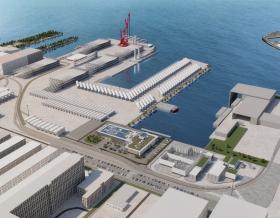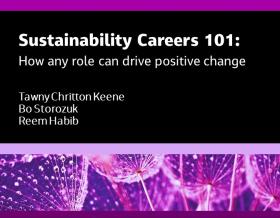Laurence Banyard is an experienced leader with ports and maritime operators globally and a leading voice in the industry’s energy transition and decarbonization challenges.
Laurence’s extensive experience in coastal and port engineering and his abilities as a divergent thinker and talent connector empowers him with the insights to support clients as they navigate the energy and power revolution. We caught up with Laurence to understand his global impact and where he sees market opportunities for clients.

How are you solving your client’s biggest challenges?
My work in climate response, specifically in energy transition and climate resilience helps clients evaluate what they want to achieve and how they will achieve it. Recently I helped a port operator in Europe by facilitating climate change workshops to empower their people to explore alternative solutions climate response.
We constantly look for ways to use technology and data solutions to help our clients improve their businesses. One client recently wanted to develop their strategy for implementing building information modeling (BIM) in their global portfolio of container terminals. By bringing together a team of ports specialists and BIM specialists, we’re helping to tailor the strategy to our client’s unique position, making sure all aspects are relevant to their port construction and operations.
Tell us about your career to date.
I've worked in ports and maritime my whole career. I started in coastal engineering in the U.K. for 13 years and then moved to Abu Dhabi, UAE for six years to work in a mixture of coastal and maritime engineering. I’ve been in Kuala Lumpur for the last nine years working on ports and maritime projects. Early in my career, a large part of my work was all around the effects of waves and rising water levels. My role was to investigate and understand how we could protect ourselves against them and how to manage them from a coastal point of view. I now apply my coastal engineering learnings to our ports clients, for example through climate risk and adaptation services for cargo terminals.
What does your current role involve?
It's a dual role. As a global principal in Ports and Maritime, I have an overview of everything Jacobs does around energy transition within ports and maritime. It's primarily about ensuring I'm knowledgeable about everything we're doing and our market so I can make the right connections between talent, technology and projects. For example, we recently introduced a client in Singapore to our team in Long Beach, California. There will soon be a green corridor between these locations, where it will be easier for ships to use green fuels by providing facilities at either end. Some of the developments, opportunities and technology on the U.S. West Coast are interesting to Singapore and vice versa. The first part of my role is making those connections internally and externally.
The second part of my role as maritime director for Asia is focused on our client offering for all our delivery of ports and maritime services in the region. While it includes the energy transition, I also promote all of our capabilities for global and regional clients. This involves strategic client discussions and identifying opportunities for Jacobs, preparing proposals, winning the work and then ensuring we produce what we said we would, delivering on the challenge.
What role do ports play in the energy transition?
Ports are a critical link as they work as vital transport and storage hubs and have the potential to provide green energy generation and transmission. However, this all comes with an asterisk. The success relies heavily on global collaboration while sidestepping a few significant obstacles — including energy source partisanship, short-term thinking, and backing the wrong technologies — but they all lead to one major challenge: tackling uncertainty. The way ports do business is quickly changing: the fuels that ships are using, the energy sources available for port equipment, the demands to provide shore power to ships — all driven by legislation, policy and market. Combine this with the recent fluctuations in shipping volumes due to the war in Ukraine, fragile political relations and economic instability, and it’s all contributing to an environment of uncertainty.
The question is: how should port operators and authorities navigate this? Here’s what is certain: ports will be the connecting points for whatever alternative energy solution is used. One of the most common proposals is harnessing offshore wind energy to split hydrogen from water by electrolysis, which can then be shipped to wherever energy is needed around the world, like today’s LNG supply network. This helps to solve the problem of inconsistent global wind climates, particularly in equatorial areas that don’t get enough wind. Each step of the chain has been demonstrated already, and it could lead to 100% of global energy requirements being met by marine renewable energy. Essentially, it requires volume and scale, and the global connectivity of ports.
We need a blueprint to start building strategic partnerships that benefit the ports and maritime industry and the global energy transition. It requires three steps, starting with greenhouse gas and energy efficiency audits which help inform longer-term decarbonization strategy. The second step involves developing deeper relationships (and opportunities) with the supply chain and investigating the different carbon scopes. Lastly, we need to use cross-industry lessons and connect with global talent to innovate.
We’re already bringing together subject matter experts in the energy and power industry to work alongside specialists within ports and maritime to create the best way forward. This cross-over of skills and connection of talent is one of the future-proof solutions to the challenge of uncertainty. Jacobs is working as a bridge in bringing together port operators and energy providers.
“The future of our work is global interconnection, but to truly understand where people are coming from, you need to go and live in other places to understand each other’s unique perspectives.”
What’s your most proud career achievement?
The most recent is an overhead power transmission line development project that provides power across the sea to the island of Penang. I've worked on it for eight years, from pre-feasibility to feasibility studies, front-end engineering and putting the tender documents together. Now it’s finally being constructed and we’re reviewing the final designs and supervising the works. It’s a first for Malaysia and we haven’t seen it done anywhere else in the world quite like this. When it’s finished, it will look spectacular, as the towers are functional but also sculptural. The design has evolved, and clever engineering has contributed to the changes while keeping the architect’s aspirations in mind. It’s rare to find a visually attractive project that still provides a practical, reliable solution — something totally different and innovative. Most projects of this type don’t get built; they don’t get through the pre-feasibility stages.
What excites you most about the future possibilities of the energy transition?
That we can achieve a global energy transition — it’s incredible that we can harness the Earth's natural energy, whether through wind or waves or heat, instead of using fossil fuels. It’s not a pipe dream; it is achievable. The commercial viability is constantly improving, and I can already see the models for how it can work.
What advice would you give young professionals in STEAM careers?
Travel. Do as much as you can throughout your career. Even though we think we're all globalized, you can't start to understand other cultures until you live there. The future of our work is global interconnection, but to truly understand where people are coming from, you need to go and live in other places to understand each other’s unique perspectives.
What do you enjoy most about being part of Jacobs?
I’ve always enjoyed it at our company, even going back 25 years. One of the reasons I originally joined was that there is always someone, somewhere, that knows the answer to your question and has faced a similar problem. Once you find that person, the learning and insight you unlock is remarkable. When I'm working on something that’s not within my usual skill set, and I find someone that’s a subject matter expert, it unlocks an opportunity for new learning — I get to learn so much from them. It’s the opportunity to learn from people leading in their fields and doing incredible things. I enjoy that feeling of the unknown, and the potential of earning insights from the most intelligent people in the world.
About the interviewee

Laurence Banyard is a Chartered Civil Engineer and experienced industry leader in ports and maritime projects. Currently responsible for winning and delivering ports and maritime engineering projects, Laurence also has extensive experience designing coastal and maritime structures, dredging and reclamation operations, ports, harbors, artificial islands, coastal developments, marinas, coast protection and beaches. Laurence has worked extensively in southeast Asia, the U.A.E. and the U.K. and has experience in St Lucia, Barbados, Cyprus, Malta, Seychelles, Morocco and Niger.
You might be interested in...
Join #OurJacobs team
What drives you drives us as we work to build a better world – together. At Jacobs, every day is an opportunity to make the world better, more connected, more sustainable. We’re always looking for dynamic and engaged people to join our team. Bring your passion, your ingenuity and your vision.












2c4e.jpg)


















_0ac2b.jpg)









2747.png)















